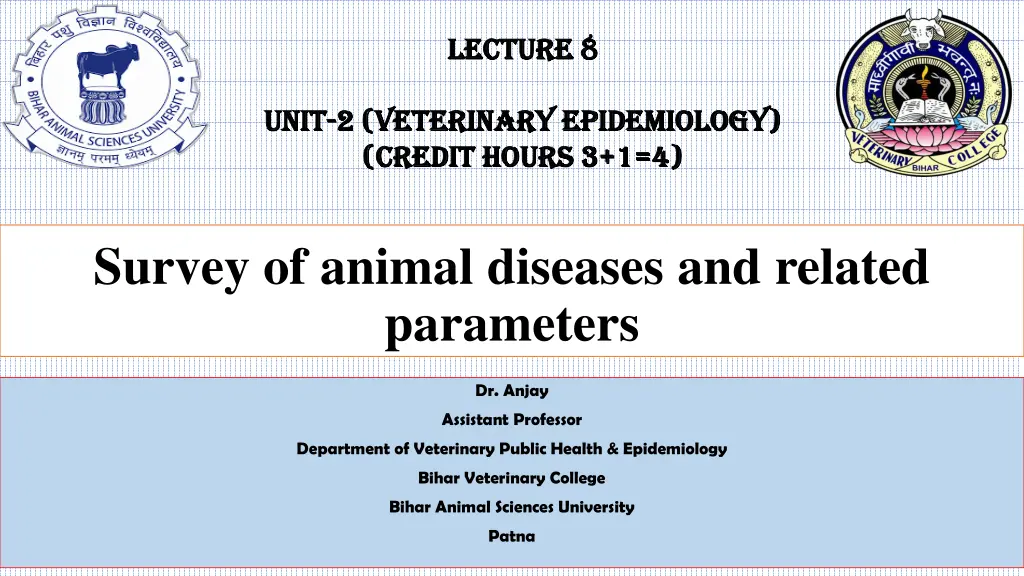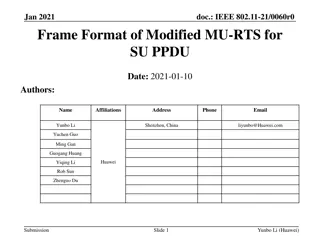
Veterinary Epidemiology Survey Techniques
Learn about survey techniques in veterinary epidemiology to estimate disease prevalence, analyze samples, and understand population characteristics. Explore terms like target population, sampling frame, and stratum in the context of animal health research.
Download Presentation

Please find below an Image/Link to download the presentation.
The content on the website is provided AS IS for your information and personal use only. It may not be sold, licensed, or shared on other websites without obtaining consent from the author. If you encounter any issues during the download, it is possible that the publisher has removed the file from their server.
You are allowed to download the files provided on this website for personal or commercial use, subject to the condition that they are used lawfully. All files are the property of their respective owners.
The content on the website is provided AS IS for your information and personal use only. It may not be sold, licensed, or shared on other websites without obtaining consent from the author.
E N D
Presentation Transcript
Lecture 8 Lecture 8 UNIT UNIT- -2 (VETERINARY EPIDEMIOLOGY) 2 (VETERINARY EPIDEMIOLOGY) (Credit Hours 3+1=4) (Credit Hours 3+1=4) Survey of animal diseases and related parameters Dr. Anjay Assistant Professor Department of Veterinary Public Health & Epidemiology Bihar Veterinary College Bihar Animal Sciences University Patna
Survey Information on disease and associated events, such as productivity, can be obtained from surveys. These involve counting members of an aggregate of units and measuring their characteristics. They may be conducted to estimate either a continuous variable such as weight and milk yield, or discrete events such as diseased animals. An important application of surveys in epidemiology is estimation of the prevalence of clinical disease, infection, or seropositive animals from samples of an animal population.
A survey of prevalence can involve: A single sample, either to determine prevalence or to determine whether or not disease is present in a group of animals; Two samples, to compare prevalence; Three or more samples.
Censuses and sample surveys If all animals in a population are investigated, the survey is a census. A census is the only means of measuring exactly the distribution of a variable in a population. Censuses can be expensive and may be difficult or impossible to conduct. However, if a survey is designed well, then a reasonably accurate and acceptable estimate of a variable can be made by examining some of the animals in the relevant population; that is, a sample.
Terms used in sampling technique Target population: It is the total population (i.e., population at risk) about which information is required. Study population: It is the population from which a sample is drawn. Example: If an investigation of parvoviral enteritis in Pomeranian is undertaken, then ideally all Pomeranian animals (the target population) should be sampled, although it may only be possible to investigate in that particular breed at dog shows or attending veterinary hospitals (the study population). Elementary units: Each unit in the study population is the elementary unit, which cannot be divided further. Stratum: A collection of elementary units grouped according to a common characteristic feature. A dairy farm is a stratum comprising cows.
Sampling frame: Before a sample is taken, members of the study population must be identified by constructing a list (i.e. sampling frame). Sampling unit: Each member of the sampling frame is a sampling unit. Sampling fraction: It is the ratio of sample size to study population size. If 10 animals were chosen from 1000 animal population, the sampling fraction would be 1%. Veterinary sampling frames include lists of abattoirs, farms, veterinary hospitals, etc.
Objectives of sampling -It is to provide an unbiased estimate of the variables that is being measured in the population. Nature of sampling units It may be individual animals or aggregates such as herd, farm.
Types of sampling Non-probability sampling Probability sampling
Non-probability sampling In which the choice of the sample is left to the investigator. 1. Convenience sampling: It is the collection of easily accessible sampling units. Example: If we want to collect faecal samples in the forest to screen the wild animals to know the status/ prevalence of parasitic diseases, collecting samples nearby entrance area (not sampling around the forest area). Selecting first 15 animals (sampling units) from the study population (or list of 150 animals in the study population).
2. Purposive or Judgmental sampling: Purposive sampling is a research technique that involves selecting participants for a study based on specific characteristics or criteria. It's also known as judgmental sampling or selective sampling. The objective is to select a sample where characteristics are balanced with those of the target population. Disadvantages Sampling by convenience Sample is not a true representative Biased estimates
Probability sampling Probability sampling in which the selection of the sample is made using a deliberate, unbiased process so that each sampling unit in a group has an equal probability or chance of being selected. This is the basis of random sampling. The following are the probability sampling methods: Simple random sampling (like lottery method) Systematic sampling Stratified random sampling Cluster sampling One-stage cluster sampling Two-stage cluster sampling Multistage cluster sampling
Simple random sampling: Selection of sample is by drawing up from a list of animals in the study population (in which each sample is having equal chance of being selected by luck). Example: If 20 cows to be selected to analyze the quantity and quality of milk production in a herd of 200 cows (study population). Code for every cow would be written on the identical sheet and then picking up a sample (cow) randomly.
Systematic sampling: The first animal is being selected randomly from the proportionate level of the study population and then selection of sampling units at equal intervals. Example: If one animal in every 10 animals is required, then the first animal would be selected randomly from the first 10. If it is 4th animal, then the samples would be 14, 24, 34, 44 and so on.
Stratified sampling: It is an accurate method because either over or under representation sampling is avoided. First the study population is divided into strata, then sample is obtained from all of the individual strata. 'Proportional allocation' is the method practiced for the stratified random sampling, where the number of sampling units selected is proportional to the number of each stratum.
Cluster sampling: Sometimes, strata are defined by geographical locations such as countries, states, districts, taluks, and villages, veterinary hospitals, veterinary dispensaries or periods of time during which samples are selected. The strata are then termed as 'clusters . It is time consuming and costly method. This can be overcome by selecting few clusters, then sampling from few elected clusters is called cluster sampling.
There are several procedures:- One-stage cluster sampling: In which selecting all animals in each selected clusters. Two- stage cluster sampling: It means selection of sample in more than one stage. The samples (all animals) of clusters selected first, followed by sub-sampling of some animals in the clusters. In which, clusters are primary units and selected members of the sub-samples are the secondary units.
Multistage cluster sampling: It is progressively higher levels of sub-sampling. First, sampling from the region. Second, sampling dairy farms in each selected region. Third, sampling cows on each selected farms. It is usually a simple random sampling. Sampling can be done even if there is an incomplete list of all members of a population. It is a most convenient and inexpensive method. But, information is less precise (example, contagious disease prevalence tends to be more variable between groups than within them). Sometimes impossible if there is no reliable demographic data. In that case, clusters can be defined by map grid.
THANKS FOR KIND ATTENTION






















